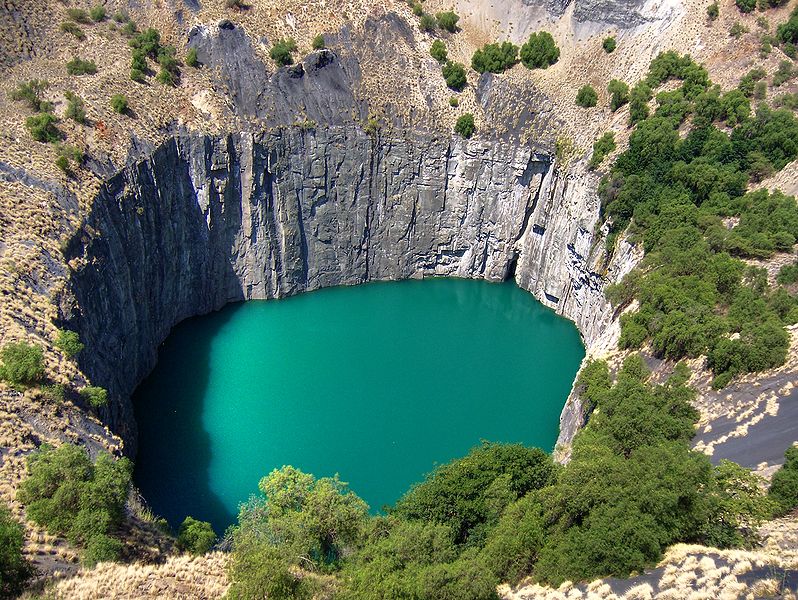Simon Tolkien & the Eternal Allure of Diamonds

Simon Tolkien has a glittering literary pedigree, to be sure—his grandfather’s best-known work is about a gold ring that exerts a dark influence over everyone who comes into contact with it. (Well, everybody except Tom Bombadil, anyway.) But Simon has long been fascinated with another precious gem, and was kind enough to share some thoughts recently on how that curiosity inspired his new novel, The King of Diamonds.
The great Kimberley diamond mine is an awesome sight to behold even now a century after it closed. The bottom is filled with blue-gray water but a hundred years ago it was alive with half-naked men swarming over the surface and burrowing down into the ground like ants, creating the largest hand-dug hole in the world. The mine is a monument to the hold that diamonds have exerted through history on the human psyche and I had the image of it in my mind when I set out in The King of Diamonds to tell a story about these jewels; about men’s insatiable desire to possess them and the consequences of that lust.

The first diamonds came into Europe from India at the time of the Roman Empire and the magic of the east meant that from the outset they were wreathed in myth and superstition. The first century writer, Pliny, claimed that all diamonds came from a single deep valley protected by seething masses of venomous snakes and later, in the Middle Ages, people believed that diamonds protected the wearer from the plague and the soldier from death in battle. Doctors were sure that ingested diamonds could heal the sick—not that they cured Pope Clement VII who was said to have swallowed 40,000 ducats worth of powdered diamonds before his very painful death in 1534.
But these early diamonds were prized for their hardness, not their beauty. Even when polished they remained dull and rough until the 17th century when the art of cutting began to be developed in the workshops of Antwerp, and the iridescent fire latent inside the stone was first released. The rose cut was followed in 1700 by the brilliant cut in which fifty-eight faceted surfaces refracted and reflected the sparkling light. Soon the breasts of the kings and queens of Europe glittered like star-studded firmaments in the candlelight and their heads and bodies were literally weighed down by hundreds of diamonds—Queen Caroline was unable to kneel in Westminster Abbey in 1727 and had to be crowned standing up.
Diamonds were common but the great diamonds were few in number. They had names of their own—the Hope, the Regency, the Koh-i-Noor—and merchants were prepared to pay fabulous sums to obtain them; sometimes they were even prepared to commit murder. These famous jewels became blood diamonds with misfortune following each successive owner to the grave. According to legend the Hope was cursed from the moment an adventurer stole it from the eye of the statue of a Hindu deity. Certainly almost all its owners met untimely deaths beginning with Louis XVI of France who was guillotined in 1793 and ending with the American heiress, Evalyn MacLean, who wore the diamond day and night, even hiring a detective to accompany her swimming, and refused to believe that the diamond was responsible for the successive sudden deaths of every member of her immediate family. The Hope finally found a home in the Smithsonian Institute in Washington where it sits today imprisoned behind bullet proof glass. It is a common destiny—most of the world’s great diamonds have now ceased their travels and are locked away in treasuries and museums.
And yet diamonds continue to fascinate. In the Second World War they were the currency of escape for European Jews caught up in the Nazi Holocaust. A diamond sewn into clothing could buy freedom, but all too often those seeking to flee were betrayed by the organizers of the escape routes. And now today the blood diamonds of Africa continue to finance bloody wars which cause untold human suffering.
Diamonds continue to fascinate just as they always will. None of the treasures of the earth are so small and yet so valuable and beautiful, and the desire for them will always lead men into temptation and deliver them into evil.
28 March 2011 | guest authors |

 Our Endless and Proper Work is my new book with Belt Publishing about starting (and sticking to) a productive writing practice.
Our Endless and Proper Work is my new book with Belt Publishing about starting (and sticking to) a productive writing practice. 
